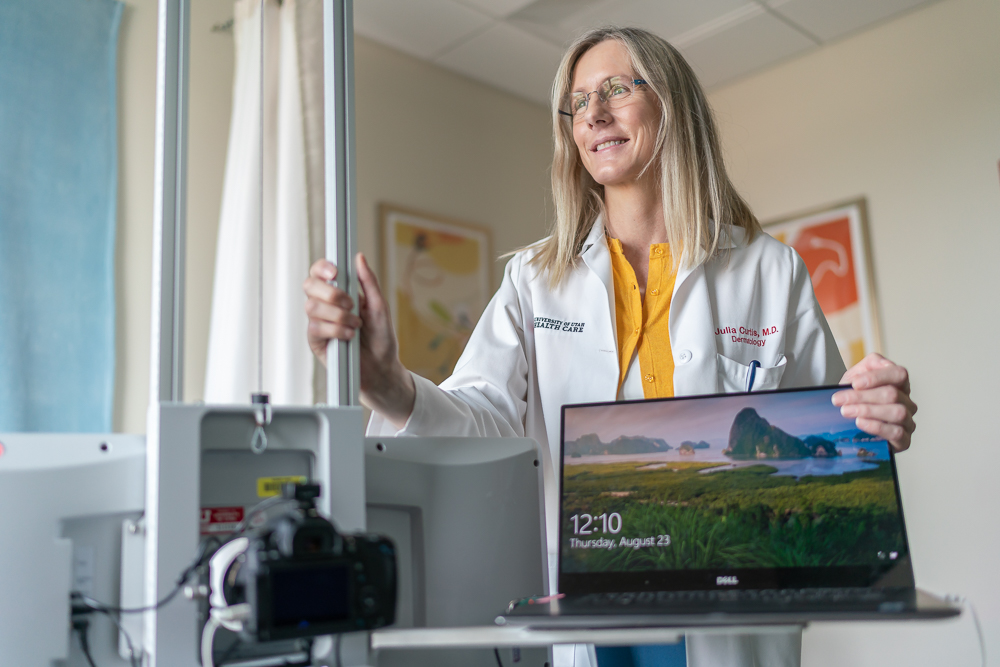Allergic Diseases
Dermatology
Allergy research is concerned with several areas. First, we are conducting several clinical studies exploring the activity of new pharmacologic agents. This work is focused on novel treatments for diseases, such as hereditary angioedema and cold urticaria and especially eosinophil associated diseases. The eosinophil associated diseases include bronchial asthma, the hypereosinophilic syndrome and the Churg-Strauss syndrome. Second, a major effort is focused upon investigation of eosinophilic esophagitis. This disease, only known since around 1990, is now occurring in almost epidemic form. Patients with eosinophilic esophagitis are usually monitored by performing esophagogastroduodenoscopy. This is an invasive procedure and we are making efforts to develop novel diagnostic technologies that will be noninvasive. As this work has proceeded, we have published several papers describing various aspects of eosinophilic esophagitis including the first complete description of the disease based on an esophagectomy specimen and an extensive study by electron microscopy of the status of infiltrating eosinophils.
Bullous (Blistering) Diseases
Dermatology
Dr. John Zone and Dr. Larry Meyer are involved in a long-term research program in blistering diseases of the skin. Dermatitis herpetiformis: Dermatitis herpetiformis is an intensely blistering disease of the skin related to intestinal celiac disease. We are currently studying the role of epidermal transglutaminase antibodies in producing the disease. These antibodies are induced by gluten intake. We are seeking efforts to stop the production of these antibodies and the extreme discomfort that they produce in affected people. Pemphigoid: Pemphigoid is a blistering disease of the skin and mucous membranes that occurs primarily in adults past the age of 50 years. It is characterized by intense itching and blistering that may involve skin, eyes, and mucous membranes. We are currently studying the role of IgE antibodies in the production of disease. We are also evaluating patients who have unusual antibody patterns. Dr. John Zone and Dr. Kristin Leiferman supervise a diagnostic laboratory that is used to diagnose these diseases and their response to therapy.
Faculty: John Zone; Larry Meyer
Psoriasis
Dermatology
Psoriasis is a common skin condition that affects about 2 out of every 100 people. The condition most commonly presents as red, scaly patches on the skin. Areas most often affected include the scalp, elbows, knees and lower back, but it can occur anywhere on the skin. Although it can be so mild that a person hardly knows they have it, it can sometimes cover the entire body. Fingernails and toenails can be affected, usually with small indentations called “pits”. Nail discoloration, thickening, and crumbling can also occur. About one quarter of people with psoriasis will also develop joint disease associated with psoriasis, known as psoriatic arthritis. It is not known what causes psoriasis, but a combination of genetic risk and environmental triggers are believed to increase a person’s risk of the condition. Recent discoveries suggest that psoriasis involves an abnormality in our own immune system. When white blood cells are triggered, they create inflammation in the skin and the development of the scaly patches. Psoriasis is more likely to occur in people who have family members with the disease. Research at the University of Utah Department of Dermatology is underway to determine the genetic variations that lead to psoriasis. Although psoriasis is not curable, it can usually be controlled with treatment. Treatment is “tailored” to an individual patient’s needs. For limited areas of involvement, topical medications (those that are applied directly to the skin) are often prescribed. For patients who do not respond well to topical mediations or who have more severe disease, dermatologists can prescribe ultraviolet light therapy (medical tanning beds), oral medications (methotrexate, cyclosporine, acitretin, and others), or injectable medications known as “biologics”. New treatments are continually under development by researchers and the pharmaceutical industry. For more information about psoriasis visit the National Psoriasis Foundation website (www.psoriasis.org) and contact your local dermatologist.
Melanoma
Dermatology
Melanoma is the most serious form of skin cancer, and Utahns are at increased risk given the prevalence of fair skinned individuals and their increased sun exposure due to high altitude and recreational activities. The department has had a long-standing interest in melanoma research, beginning with the participation of John Zone and Larry Meyer in the identification of p16 gene mutations in Utah families with hereditary melanoma in the 1990s. More recently, partnering with the Huntsman Cancer Institute where patients with advanced disease are seen for multidisciplinary melanoma care, several of our faculty have been involved in melanoma research that includes basic science, genetics and epidemiology, behavioral and population research, translational research, and clinical trials. Sancy Leachman (recently moved to Oregon Health Sciences Univ.) is studying patient behaviors in response to genetic test reporting of p16 mutations. David Goldgar works on genetics of melanoma and other cancers, investigating predisposition genes. Doug Grossman is studying mechanisms underlying melanoma development and metastasis, the role of photography in early detection of melanoma, and currently is leading a chemoprevention trial in high-risk patients.
Faculty: John Zone; Larry Meyer; Sancy Leachman; David Goldgar; Doug Grossman


